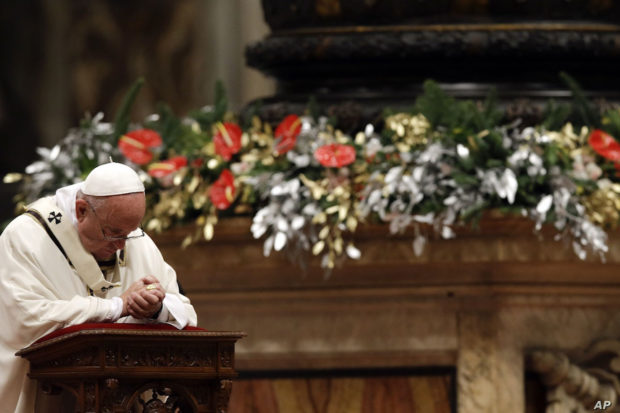Pope Francis defends sights and sounds of Christmas

AP PHOTO
In the 7th century, St. Sophronius (560-638 AD), Patriarch of Jerusalem, sent to Pope Theodore I a thumb-sized relic that Christians believe to be part of Jesus’ manger. A couple of weeks ago, when the tiny wooden relic returned to its permanent home in Bethlehem, the birthplace of Jesus Christ, the crowd greeted it with cheerful adoration. Contained in an ornate case, the relic’s permanent home is the Franciscan Church of St. Catherine next to the magnificent Basilica of the Nativity, on the West Bank, Palestine.
Click Here for the Amazon Deal of The Day
Today, the Christmas Belen – with Jesus in a manger, Mary, Joseph, and the Magi – reminds us that, historically, “the Word was made Flesh and dwelt amongst us” (John 1:14). This week, Pope Francis traveled to the exact spot in Greccio, East of Rome, where St. Francis of Assisi in 1223 started the holy tradition of setting up the first Belen and there signed the Apostolic Letter entitled Admirabile Signum or “Wonderful Sign,” which explains the importance of the nativity scene.
There too, in a (supposedly) more tolerant time of universal respect for different religious beliefs, the Holy Father has to defend the yearly custom of displaying the Belen in public places like “the workplace, in schools, hospitals, prisons, and town squares.” Annually, during the Yuletide season in countries like France and the United States, the public setting up of the nativity scene has become a contentious legal issue, which according to those who oppose it is a violation of their Constitution that prohibits the establishment of a state religion.
I don’t think that kind of legal argument will hold sway in places enriched by multi-socio-cultural and religious history, where the separation of Church and State does exist, yes, but the public symbolism and ancient celebrations are tolerated or even declared a holiday, walang pasok. You can’t just dust age-old traditions off the human soul and tell the Mexicans to stop commemorating their departed ones in El Dia de los Muertos on November 1, in which you find “Skeleton on your Bread” as a reminder.
Click Here for the Amazon Deal of The Day
You can’t tell the citizens of India not to celebrate the Hindu Diwali, when farmers dress up their cows with colorful decorations and millions of tiny flames light up the entire nation during the festival of lights. You can’t tell the Bicolanos to stop celebrating the annual Our Lady of Peñafrancia’s fluvial parade in September and the million devotees the annual Poong Nazareno traslacion in January. For five solid centuries, devotees still experience the deep impact of Kaplag or the rediscovery of the miraculous image of Santo Niños in 1565. So, how on earth do you tell them to cease observing the annual Sinulog in Cebu, Dinagyang of Iloilo, and the Ati-Atihan festival in Aklan?
The public Belen goes with the sounds and sights of the Yuletide season, when you hear the We-three-kings-of-Orient-are Christmas carol written by John Henry Hopkins Jr. in 1857 and rendered by Anne Murray, or the “O Holy Night… It is the night of our dear Saviour’s birth,” composed by Adolphe Adam in 1847 and sung by Josh Groban or Andrea Bocelli, mixed with the Jackson 5 Christmas selection.
It might be that the sounds and sights of Christmas has become offensive to our highly-consumeristic and secular world because they draw attention to Christo-centric history, the time of the historical coming of Jesus, the Son of God, 2,000 years ago.
Does Christo-centric history also mean that the Child Jesus so deeply marked and redeemed all humankind that the chronology of history is defined by His birthday, the undeniable landmark of which is the acronym BC and AD or Anno Domini, the Year of the Lord. Notice how, in all business-or-personal-or-socio-cultural encounters among the Muslims of Saudi Arabia, the Shintoists of Japan, the Hindu scholars of India, the Buddhists of Bhutan, and even among atheists, whether you like it or not, the modern man marks the modern dates with reference to the birth of the Child Jesus by using BC and AD.
Click Here for the Amazon Deal of The Day
Sometimes, you find in history books BCE and CE as alternatives to the Gregorian Calendar’s BC and AD usage, but it’s exactly the same. BCE (Before the Common Era) is the era before the Current Era (CE). Hence, 2021 AD is 2021 CE and the point of reference is the Emmanuel, “God with us,” born in a wooden manger in Bethlehem. And as the Christmas carol goes:
O little town of Bethlehem
How still we see Thee lie…
For Christ is born of Mary…
While mortals sleep, the angels keep.
Jose Mario Bautista Maximiano (facebook.com/josemario.maximiano) is the author of 500 YEARS ROMAN CATHOLIC (2020) and 24 PLUS CONTEMPORARY PEOPLE: God Writing Straight with Twists and Turns (Claretian, 2019).

